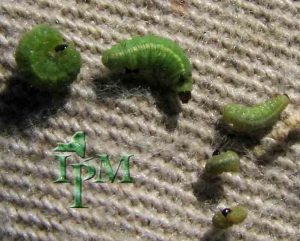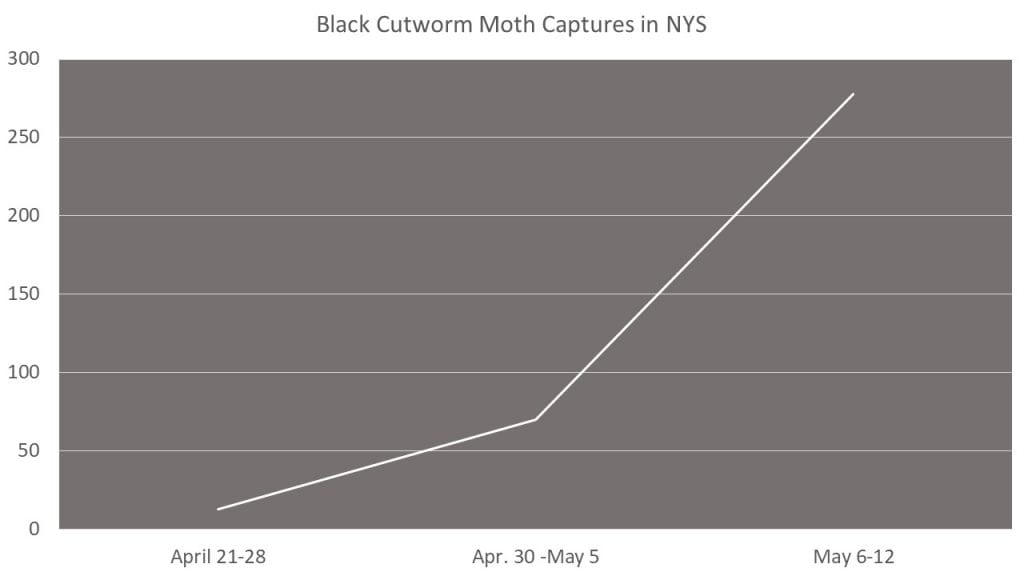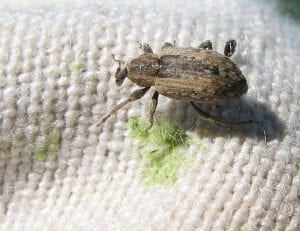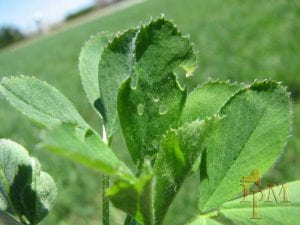Volume 18-Number 3
Contents
View from the Field
The theme for last week was rain. With the excess moisture, it is making it hard to plant fields. We had a report of spring black stem in alfalfa in Cayuga County. Alfalfa weevil (AW) adults have been found in alfalfa in Western NY. AW activity will increase with rising temperatures. They will be laying eggs this week and you may see a few early 1st instar larvae.
There have been significate captures of black cutworm moths in several areas of the state ranging from Dutchess County in Eastern NY to Seneca County in Western NY. As cornfields are planted watch for black cutworms clipping off plants near the soil surface. Note that we have caught true armyworm moths but are at low numbers so far.
Weather Outlook – May 16, 2019
Jessica Spaccio
NOAA Northeast Regional Climate Center, Cornell University
Last week temperatures ranged from 2 to 8 degrees below normal. Precipitation has ranged from 1” to over 4”. Base 50 growing degree-days were less than 30.
Rain possible Thursday night into Friday, and some unsettled weather next week, but overall a much drier week with temperatures near-normal.
Today will be mostly dry with partly to mostly sunny skies and temperatures in the 50s to mid 60s. Overnight lows will be in the 40’s, with a chance of showers overnight into Friday.
Friday will be in the 60s with showers, ending in the afternoon. Overnight temperatures will be in the 40s.
Saturday temperatures will be in the 60s and low 70s with dry conditions. Overnight temperatures will be in the 40s, a few showers are possible.
Sunday highs will be in the 60s to 70s with mostly dry conditions. Overnight temperatures will be in the 40s with showers overnight into Monday.
Monday temperatures will be in the 60s to 70s. Overnight temperatures will be in the 40s with showers possible overnight into Tuesday.
Tuesday highs will be in the 60s to low 70s with scattered showers possible. Overnight temperatures will be in the 40s.
Wednesday highs will be in the 60s to low 70s with scattered showers possible. Overnight temperatures will be in the 50s.
The seven-day precipitation amounts will range from ¼” to near 1 ½”.
The 8-14 day outlook (May 23-29) favors above-normal temperatures for all of NY, slightly favors above-normal precipitation for western NY and slightly favors below-normal precipitation for southeast NY.
National Weather Service watch/warnings map
Alfalfa Weevil is Slowly Appearing
Jaime Cummings and Ken Wise, NYS Integrated Pest Management Program
Alfalfa field near Aurora in Cayuga County, May 8. (Photo by J. Cummings, NYS IPM)
Despite this cold, wet spring which has delayed planting and other farming efforts across NY, our pests and diseases continue to rear their ugly heads. The cold had been slowing down some of our insect pests, but the alfalfa weevil has been detected in some fields, though currently at low numbers. This serves as your reminder that although it is cold and wet out, we need to continue to be vigilant with our scouting efforts for early detection of pests to make sound management decisions.
Figure 1. Various instars (growth stages) of the alfalfa weevil larvae, and an adult weevil (Photos by Ken Wise, NYS IPM)
Keep in mind that the alfalfa weevil overwinters in NY and is typically more of a problem in established stands where they emerge in the spring and lay eggs in alfalfa stems. The larvae cause the most of the damage as they go through four instar growth stages; and the fourth instar causes the most damage (Fig. 1). Feeding damage from this pest initially looks like small shot-holes in the leaves in the upper canopy, but can quickly progress toward defoliation under high pest pressure (Fig. 2). During a cold spring, like we are currently experiencing, the alfalfa usually develops faster than the weevils, and we’ll see a delay in weevil emergence and feeding damage. This year, we are a couple weeks behind when we usually start seeing noticeable damage, and you want to get out scouting now for the weevils and continue to do so weekly through first harvest and early regrowth.
Figure 2. Small ‘shot holes’ in leaves are early signs of the pest, which may progress and eventually result in defoliation. (Photos by Ken Wise, NYS IPM)
Scouting for the alfalfa weevil involves walking a random pattern in the field and stopping to collect a stem every 10 steps. Once you have 10 stems, visually inspect the stems for weevil tip-feeding injury, and count each stem showing tip-feeding injury within the top three inches to determine a percentage of damaged stems. Repeat this collection of 10 random stems five more times throughout the field for a total of 50 stems inspected. Repeat this scouting in different patterns within the field weekly.
Follow the established action thresholds based on harvest schedules. Before first cutting, if 40% of the stems have damage, then management options should be considered. If approaching threshold, early harvest is a good option. Otherwise, if you’re unable to manage with an early harvest, and weather permitting, you may consider an insecticide application. Always consult label instructions and follow Cornell Guidelines for pesticide applications. Given our ‘late’ spring and late emergence of this pest, an early harvest this year will likely be sufficient for management in fields at high risk or at threshold. After harvest, always check the regrowth regularly for signs of feeding. If 50% of the regrowth shows damage and larvae are <3/8” long, then you may need to consider a follow-up insecticide application. But, keep in mind all factors when considering an insecticide application, including cost, pre-harvest intervals, and weather constraints. And remember, mixed stands with <50% alfalfa or poor stands of alfalfa should not be sprayed for this pest, because the return on investment is not likely in those situations. Never spray alfalfa that is in bloom. Not only is it illegal, but it endangers many pollinators and other beneficial insects. Keep in mind that at least 13 species of natural biocontrol parasites of this pest exist in NY, and each pesticide application aimed at managing the weevil also kills off your beneficial insects and parasites. The more beneficial parasites you have, the less likely you’ll have alfalfa weevil issues above threshold.
Alfalfa weevil larva in a cocoon, which will emerge as an adult weevil. (Photo by Ken Wise, NYS IPM)
Waterhemp Herbicide Resistance Tests: Preliminary results
Bryan Brown, New York State Integrated Pest Management
Collaborators: Antonio DiTommaso, Kathleen Howard, Mike Hunter, Jeff Miller, Scott Morris, Jodi Putman, Peter Sikkema, Mike Stanyard
Last summer, several populations of waterhemp (Amaranthus tuberculatus) survived herbicide applications in western NY corn and soybeans.
Growers asked if these weeds are actually resistant to certain herbicides. If so, which ones? And are all populations of western NY waterhemp resistant to the same herbicides, or do they differ?
To answer these questions, we collected seed from these surviving weeds at three locations in NY, we grew them in a Cornell University greenhouse alongside a population of waterhemp that we know is susceptible to herbicides, and then we used a spray chamber to apply a range of herbicides and rates.
The herbicides we used were glyphosate (i.e. Roundup, WSSA Group 9), atrazine (i.e. Aatrex, WSSA Group 5), lactofen (i.e. Cobra, WSSA Group 14), and imazethapyr (i.e. Pursuit, WSSA Group 2). The WSSA groups represented here are the ones waterhemp has developed the most resistance to in other states. For each herbicide, we used five different rates. Each rate was applied to five waterhemp plants from each population. Following the methods of other studies, plants were sprayed when they were around 5” tall. BASF Agricultural Solutions and Valent USA LLC supplied some of the materials for this study.
We’ll be doing a final analysis three weeks after spraying. But here’s how the NY populations look after only one week. At the full labelled rates, glyphosate resulted in 50% control and lactofen resulted in 99% control. Atrazine and imazethapyr resulted in poor control, but waterhemp plants were larger than the maximum size stated on the label.
But it’s the comparison of our three NY populations to the susceptible population that determines resistance. Final control ratings will be done in two weeks, but initial results indicate that two NY populations are potentially resistant to glyphosate, three are potentially resistant to atrazine, none are likely resistant to lactofen, and two are potentially resistant to imazethapyr. So herbicides in WSSA Groups 2, 9, and 5 shouldn’t be solely relied on to control this weed.
Since there were some differences between NY populations, we’ve shared each farm’s results with the participating growers so they can make the necessary changes to their management plan.
So if you don’t have it already, keep an eye out for waterhemp this year. It looks similar to other NY pigweeds, except that it’s completely hairless and it has separate male (pollen-producing) and female (seed-producing) flowering heads. Since it can travel in seed, feed, and equipment ¬– make sure they’re clean. And think about trying out some new weed control options.
Photo caption: Bryan Brown is coordinating a project testing waterhemp for resistance to herbicides.
Black Cutworm Moth Captures
The black cutworm moths capture have increased dramatically from last April. We are still waiting on some data to come in for last week.
| The week of | |||||
| County | Town | April 21-28 | Apr. 30 -May 5 | May 6-12 | May 13-19 |
| Delaware | Davenport Center | NA | 0 | 6 | 16 |
| Dutchess | Amenia | NA | 5 | 29 | 45 |
| Lewis | Martinsburg | NA | 0 | 93 | 84 |
| Livingston | Caledonia | NA | 0 | 4 | 4 |
| Livingston | Lima | NA | 3 | 5 | 10 |
| Oneida | Kirkland | NA | 4 | 4 | 35 |
| Oneida | Westmorland | NA | 0 | 9 | 3 |
| Onondaga | Memphis | NA | 0 | 0 | 0 |
| Seneca | Seneca Falls | 12 | 29 | 64 | 35 |
| Tompkins | Ulysses | NA | 5 | 6 | 0 |
| Washington | Argyle | NA | 0 | 0 | 0 |
| Washington | Easton | NA | 0 | 4 | 3 |
| Washington | Fort Edward | NA | 1 | 3 | 2 |
| Washington | Stillwater | NA | 3 | 4 | 3 |
| Wayne | Ontario | 1 | 1 | 5 | 4 |
| Wyoming | Castile | 0 | 19 | 42 | 15 |
| TOTAL | 13 | 70 | 278 | 201 |
True Armyworm Moth Captures
| County | Town | April 21-28 | Apr. 30 -May 5 | May 6-12 | May 13-19 |
| Dutchess | Amenia | NA | 0 | 0 | 0 |
| Delaware | Davenport Center | NA | 0 | 0 | 0 |
| Livingston | Lima | NA | 1 | 2 | 8 |
| Oneida | Kirkland | NA | 0 | 1 | 0 |
| Oneida | Westmorland | NA | 0 | 3 | 2 |
| Onondaga | Memphis | NA | 0 | 0 | 1 |
| Lewis | Martinsburg | NA | 0 | 0 | 0 |
| Livingston | Caledonia | NA | 1 | 0 | 2 |
| Washington | Argyle | NA | 0 | 0 | 0 |
| Washington | Easton | NA | 0 | 0 | 0 |
| Washington | Fort Edward | NA | 0 | 0 | 0 |
| Washington | Stillwater | NA | 0 | 1 | 0 |
| Seneca | Seneca Falls | 0 | 0 | 12 | 2 |
| Wayne | Ontario | 0 | 0 | 0 | 0 |
| Tompkins | Ulysses | NA | 0 | 0 | 0 |
| Wyoming | Castile | 0 | 0 | 0 | 2 |
| 0 | 1 | 7 | 17 |
New York Field Crop Pest Degree Day Accumulations for selected locations
May 19, 2019
Clipboard Checklist
Keith Waldron, NYS IPM
General
*Walk fields to check tile flow, check and clear drainage outlets. Look for line breaks
*Note and record location of wet areas on field maps or aerial photo for future tiling considerations and crop decisions, check for areas of soil erosion
*Pre-plant weed evaluation, timing cultivation and/or pre-plant weed management
*Watch for early season weeds: winter annuals, chickweed, henbit, field penny cress, shepherd’s purse, giant and common ragweed, purple deadnettle, lambsquarters, redroot pigweed, velvet leaf, Pennsylvania smartweed, common sunflower, quackgrass, foxtail
Alfalfa:
*Evaluate established legume stands for winter damage (thinning stand, frost heave, Brown root rot), determine average alfalfa stand count adjust crop plans if necessary
*Monitor for alfalfa weevil, crown or foliar diseases
*Monitor new seedings for Pythium blight and Phytopthora Root Rot.
*Monitor for Alfalfa Snout Beetle (In Oswego, Jefferson, Cayuga, Wayne, Lewis, St. Lawrence, Clinton, Essex, and Franklin counties)
Small Grains:
*Monitor winter grain fields for over wintering survival (snow mold and other cold injury issues), weed issues (such, as winter annuals, corn chamomile and chickweed), growth stage, number of tillers, foliar diseases (powdery mildew, rusts)
*Check stands for soilborne virus diseases, Wheat spindle streak mosaic and Soilborne wheat mosaic, check for signs of powdery mildew or other maladies, cereal leaf beetle, weed escapes, goose damage
Corn:
*Prepare land and plant corn as conditions allow
*Pre-plant weed evaluation, timing cultivation and/or pre-plant weed management
*Emergence: assess stand, population count
Soybeans:
*Prepare land and plant soybeans as conditions allow
*Pre-plant weed evaluation, timing cultivation and/or pre-plant weed management
Pastures:
*Check and mend fences as needed.
*Check crop growth
*Monitor fields for invasive species, plants harmful to livestock
*Review/Plan rotation system
Equipment:
*Remove / clean soil and crop debris from equipment
*Arrange for custom weed control or check your own application or cultivator equipment for repairs.
*Carry appropriate / necessary NYS DEC and EPA required documents: (pesticide applicators license, pesticide labels, MSDS sheets, etc.) with application equipment
*Calibrate:
-planting equipment – maintain records on planting rate per field
-manure spreaders – maintain records on amount spread per field
-pesticide application equipment – Check nozzles, pumps, etc., recalibrate pesticide application equipment before use.
Storage:
* Check stored grain bins for temperature, moisture and signs of mold and insects. Aerate, core, transfer grain or treat as necessary
*Check forage allocation and anticipate feed program adjustments as forages from previous year are used up
*Plan where forages should be stored for optimum allocation next feeding season












